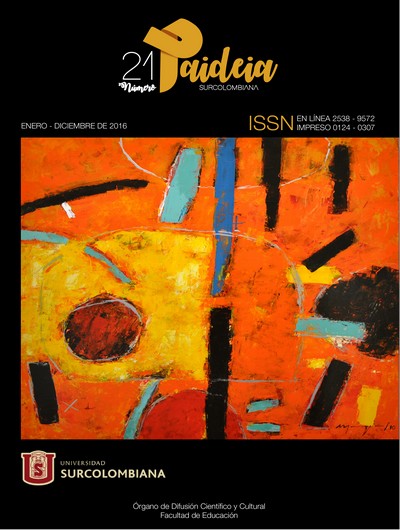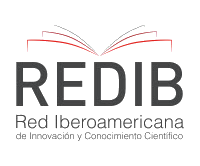Game and attention deficit ... the biology of knowledge and human motives
##plugins.themes.bootstrap3.article.main##
The sense of developing this work is re-signify the Disorder Attention Deficit and Game so used in the schoolchild's talks and education system in general to induce new forms and disciplinary approaches closer to the conditions and characteristics of living of girls and boys in ADHD situation. Not only as a functional interest or effective, but rather existential and consistent with our condition of human being in an auto poetic- relational becoming.
Downloads
##plugins.themes.bootstrap3.article.details##
APA. (2013). Diagnostic and statistical manual of mental disorders (5ª. ed.). Washinton, DC: American Psychiatric Association.
Bajtín, M. (1989). Estética de la creación verbal. México: Siglo XXI.
Bjorklund, D. y Gardiner, A. (2011). Object play and tool use. Development and evolutionary perspectives. En Pelligrini, A. The oxford handbook of the devolopment of play. Oxford University Press: New York
Bundy, A., Luckett, T., Naughton, G., Tranter, P, Wyver, S., Ragen, J, Singleton, E. y Sples, G. (2008). Playful interaction: occupational therapy for all children on the school playground. American Journal of Occupational Therapy, 62(5), 522-527.
Buytendijk, F. (1977). O jogo humano. En Gadamer, G.y Vogler, P. Nova antropologia. EDUSP: Sâo Paulo.
Carroll, X., Yi, H., Liang, Y., Pang, K., Leeper-Woodford, S., Riccardi, P., Liang, X. (2012). Family-environmental factors associated with attention deficit hyperactivity disorder in chinese children: a case-control study. PLoS ONE 7(11). doi:10.1371/journal.pone.0050543.
Cassasus, J. (2014). Introducción a la educación emocional. Revista Genuina Nº1, 75-86.
Claro, S. (2015). Luche-mundo: una metodología para el abordaje responsable y dialógico del TDAH. Estudios Pedagógicos. Número Especial.
Cervini, R. (2002). Participación familiar y logro académico del alumno. Revista Colombiana de Educación, 43, 69-102.
Chu, K., Li, S., Chen, Y., Wang, M. (2012). Family dynamics in families with children with Attention Deficit Hyperactivity Disorder. Shanghai Archives of Psychiatry, 24(5):279-85.
Cordier, R., Bundy, A., Hocking, C., & Einfeld, S. (2009). A model for play-based intervention for children with ADHD. Australian Occupational Therapy Journal, 56, 332-340.
Cussen, A., Sciberras, E., Ukoumunne, O.C., Efron, D. (2012). Relationship between symptoms of attention-deficit/hyperactivity disorder and family functioning: a community-based study. European Journal of Pediatrics, 171(2):271-80.
De Macedo, L (2012). El desarrollo psicológico del juego y la educación. En Carretero, M. y Castorina, J (2012). Desarrollo cognitivo y educación (II), procesos del conocimiento y contenidos específicos. Pp. 145 – 167. Buenos Aires: Paidós.
DuPaul, G. J. & Weyandt, L. L. (2006). School‐based Intervention for Children with Attention Deficit Hyperactivity Disorder: Effects on academic, social, and behavioural functioning. International Journal of Disability, Development and Education, 53(2), 161-176.
Fisher, K.; Hirsch-Pasek, K; Golinkoff, R; Singer D. y Berk, L. (2011). Playing around in school: Implication for learning and educational policy. En Pellegrini, A. The oxford handbook of the devolopment of play. Oxford University Press: New York.
Flores, L. (2003) Fenomenología de la espacialidad en el horizonte de la corporalidad. Teología Vida [online], 44(2-3), 265-269.
Foley, M. (2011). A comparison of family adversity and family dysfunction in families of children with attention deficit hyperactivity disorder (ADHD) and families of children without ADHD. Journal for Specialists in Pediatric Nursing, 16, 39-49.
Freeman, W. (2007). Dinámicas no lineales e intencionalidad: El rol de las teorías cerebrales en las ciencias de la mente. En Ibáñez, A. y Cosmelli, D., Nuevos enfoques de la cognición –re-descubriendo la dinámica de la acción, la intención y la intersubjetividad. Santiago de Chile: Universidad Diego Portales.
Freire, P. y Faúndez, A. (2012). Por una pedagogía de la pregunta. Barcelona: Siglo XXI.
Frigerio, A., Montalia, L., & Fine, M. (2013). Attention deficit/hyperactivity disorder blame game: A study on the positioning of professionals, teachers and parents. Health, 17(6), 584-604.
Gallagher, Sh., Schmicking, D (2010). Handbook of Phenomenology and Cognitive Science. Berlin: Springer.
Gallagher, Sh., (2012). Phenomenology. London: Palgrave-Macmillan.
Gadamer, H (1977). Verdad y Método I. Fundamentos de una hermenéutica filosófica. Salamanca: Sígueme.
Goldstein, J. (2011). Technology and play. En Pellegrini, A. The oxford handbook of the devolopment of play. Oxford University Press: New York.
García Bacete, F. J. (2003). Las relaciones escuela-familia: un reto educativo. Infancia y aprendizaje, 26(4), 425-437.
Harris, P. (2005). El funcionamiento de la Imaginación. Ciudad de México: Fondo de la Cultura Económica.
Howes, C. (2011). Social play of children with adults and peers. En Pellegrini, A. The oxford handbook of the devolopment of play. Oxford University Press: New York.
Huizinga, J (2014). Acerca de los límites entre lo lúdico y lo serio en la cultura, (trad. de Goedele de Sterck). Madrid: Casimiro.
Kamii, M y De Vries, R. (1988). Juegos colectivos en la primera enseñanza. Implicaciones de la teoría de Paiget. Madrid: Visor.
Kvaale, E. P., Haslam, N., & Gottdiener, W. H. (2013). The ‘side effects’ of medicalization: A meta-analytic review of how biogenetic explanations affect stigma. Clinical Psychology Review, 33(6), 782-794.
Langeveld, J. (2004) Escuchar y mirar (+2CDs). Madrid: Akal/ Entorno musical.
Lebowitz, M. S., Rosenthal, J. E., & Ahn, W.-k. (2012). Effects of biological versus psychosocial explanations on stigmatization of children with ADHD. Journal of Attention Disorders.
Leipold, E. y Bundy, A. (2000). Playfulness in children with attention déficit hyperactivity disorder. OTJR: Occupation, Participation and Health, 20(1), 61-79.
López de Maturana, S. (2010). El Juego como manifestación cuántica. Aproximación a la epistemología infantil. Revista Polis, 9(25), 243-254.
Malacrida, C. (2004). Medicalization, ambivalence and social control: Mothers’ descriptions of educators and ADD/ADHD. Health, 8(1), 61-80.
Mandoki, K. (2008) Estética cotidiana y juegos de la cultura. México D.F.: Siglo XXI.
Mautone, J. A., Lefler, E. K., & Power, T. J. (2011). Promoting Family and School Success for Children With ADHD: Strengthening Relationships While Building Skills. Theory Into Practice, 50, 43-51.
Maturana, H. (1999). Transformación en la convivencia. Santiago de Chile: Dolmen.
Maturana, H. y Mpodozis, J. (1987). Percepción conductual del objeto. Arch. Biol. Exper. Nº20, 319-324.
Maturana, H.R. and G. Verden-Zoller. (1993). Amor y juego, fundamentos olvidados de lo humano. Instituto de Terapia Cognitiva. Santiago de Chile: Noreste.
Maturana, H. y Pörksen, B. (2004) Del ser al hacer. Los orígenes de la biología del conocer. J.C. Sáez Editor: Santiago de Chile.
Merleau-Ponty, M (2000). Fenomenología de la percepción. Barcelona: Península.
Merleau-Ponty, M. (2004). O Olho e o espírito. Sao Paulo: Cosac & Naify.
Milicic, N. (2012). A ser feliz también se aprende. Barcelona: Grijalbo.
Molina, B., Hinshaw, S., Swanson, J., Arnold, E., Vitiello, B., Jensen, P., Group, M. C. (2009). The MTA at 8 years: prospective follow-up of children treated for combined type ADHD in a multisite study. Journal of the American Academy of Child Adolescent Psychiatry, 48(5), 484-500.
Noë, A. (2010). Fuera de la cabeza. Por qué no somos el cerebro y otras lecciones de la biología de la consciencia. Barcelona: Kairos.
Noë, A. (2012). Varieties of presence. Boston: Harvard University Press.
Oord, S. V. d., Prins, P. J. M., Oosterlaan, J., & Emmelkamp, P. M. G. (2008). Efficacy of methylphenidate, psychosocial treatments and their combination in school-aged children with ADHD: A meta-analysis. Clinical Psychology Review, 28, 783-800.
Pelham, W., & Fabiano, G. (2008). Evidence-based psychosocial treatments for Attention-deficit/hyperactivity disorder. Journal of Clinical Child & Adolescent Psychology, 37(1), 184-214.
Pelham, W., Gnagy, E., Greiner, A., Hoza, B., Hinshaw, S., Swanson, J., McBurnett, K. (2000). Behavioral versus behavioral and pharmacological treatment in ADHD. Children attending a summer treatment program. Journal of Abnormal Child Psychology, 28(6), 507-525.
Pellegrini, A. (2011) The Oxford handbook of the development of play. Oxford: Oxford University Press.
Philipp, D. (2012). Reflective family play: A model for whole family intervention in the infant and preschool clinical population. Infant Mental Health Journal. (33), 6, 599-608.
Polanczyk, G., de Lima, M. S., Horta, B. L., Biederman, J., & Rohde, L. A. (2007). The worldwide prevalence of ADHD: A systematic review and metaregression analysis. American Journal of Psychiatry, 164(6), 942-948.
Puig, I. y Sátiro, A. (2008). Jugar a pensar. Recursos para aprender pensar en educación infantil. Barcelona: Octaedro.
Ronis, S., Baldwin, C., McIntosh, S., McConnochie, K., Szilagyi, P., Dolan, J. Caregiver preferences regarding personal health records in the management of ADHD. Clinical Pediatrics, 54(8), 765–774.
Sánchez-Pérez, N. y González-Salinas, C. (2013). Ajuste escolar del alumnado con TDAH: factores de riesgo cognitivos, emocionales y temperamentales. Electronic Journal of Research in educational psychology, 11(2), 527-550.
Sátiro, A. (2006). Jugar a pensar con mitos. Barcelona: Octaedro.
Scheffler, R. M., Hinshaw, S. P., Modrek, S., & Levine, P. (2007). The global market for ADHD medications. Health Affairs, 26(2), 450-457.
Scheuerl, H. (1994). Das spiel. Untersuchungen über sein wesen, seine pädagogische möglichkeiten und grenzen. Weinheim: Beltz Verlag.
Simondon, G. (2009). La individuación a la luz de las nociones de forma y de información. Ediciones la Cebra: Buenos Aires.
Terr, L. (2000). El juego: por qué los adultos necesitan jugar. Buenos Aires: Paidos.
Toro, S.; Arteaga, A. y Paredes C. (2015). Corporeidad y aprendizaje auténtico, dinámicas relacionales en contexto de la motricidad escolar. En Correa, A. y Mizuno, F., Org.: Motricidad escolar. (pp. 59-78). Curitiba, PR: CRV.
Toro, S.; Peña M. Y Mujica, N. (2015) el futbol de barrio como proceso educativo no formal. Un estudio de casos en la ciudad de Valdivia-Chile. Revista Movimento. En evaluación.
Toro A, Sergio, & Niebles, Ángela. (2013). Corporeidad y aprendizaje en el contexto de la Enseñanza General Básica: comprensión y descripción de los procesos de construcción de conocimiento desde la acción relacional de los actores. Estudios pedagógicos 39(1) 269-284.
Toro, S. (2010). Neurociencias y aprendizaje, un texto en construcción. Estudios Pedagógicos, 36(2), 323-341.
Torres, C. (2002). El juego como estrategia de aprendizaje en el aula. Repositorio Institucional de la Universidad de los Andes, 115-134.
Trigo, E (2007). Creatividad, Motricidad y Ludismo. Popayán: Universidad El Cauca.
Uribe, C. A., & Rojas, R. V. (2007). Factores culturales en el trastorno por déficit de atención e hiperactividad: Habla la mamá. Revista Colombiana de Psiquiatría, 36(2), 255-291.
Van Manen, M. (2004). El tono en la enseñanza. El significado de la sensibilidad pedagógica. Barcelona: Paidós.
Varela, F. (2000). El fenómeno de la vida. Santiago de Chile: Dolmen.
Valsiner, J. (2001). Comparative study of human cultural development. San Sebastián: Fundación Infancia y Aprendizaje.
Vayer, P. Psicologia das acçoes corporais. Lisboa: Instituto Piaget.
Vigostky, L., Luria, A., Leontiev, A (2011). Psicología y Pedagogía. España: Akal.
Vicente, B., Saldivia, S., De la Barra, F., Melipillán, R., Valdivia, M., & Kohn, R. (2012). Salud mental infanto-juvenil en Chile y brechas de atención sanitarias. Revista Médica de Chile, 140, 447-457.
Villalobos, M.A. (2009). El rol del maestro frente a la construcción del juego simbólico en los niños. Revista Diversitas - Perspectivas en Psicología, 5(2), 269 - 282.
Wilde, R. (2002). Educar para ser. Quito: Fundación Educativa Pestalozzi.
Willcutt, E. (2012). The prevalence of DSM-IV Attention-Deficit/ Hyperactivity Disorder: A meta-analytic review. Neurotherapeutics, 9, 490-499.
Zurita Rivera, U. (2009). La participación social y las reformas educativas en América Latina. La discusión pendiente. En A. M. Goetschel (coord.), Perspectivas de la educación en América Latina. Ecuador: FLACSO-Ecuador/ Ministerio de Cultura.














